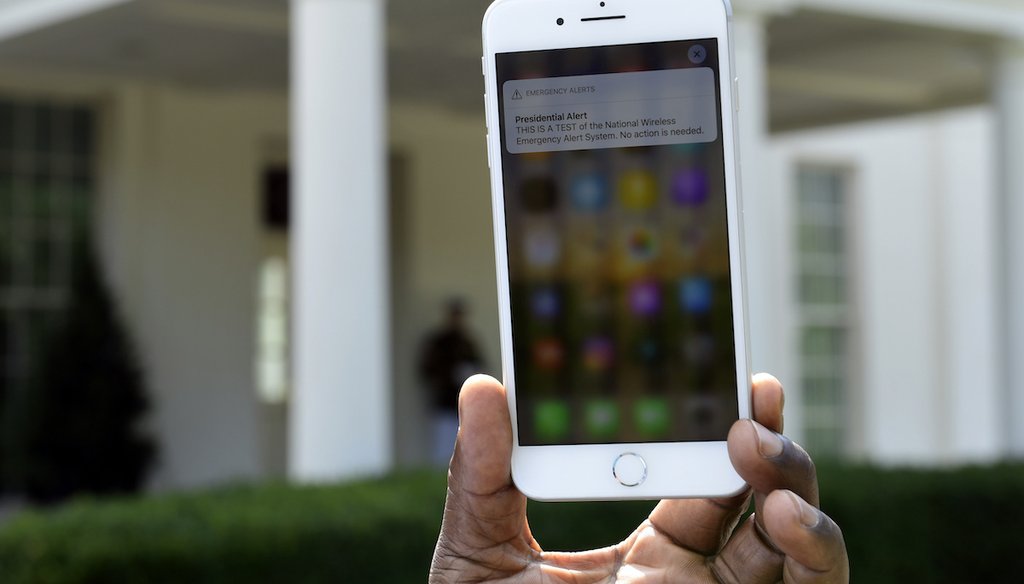Stand up for the facts!
Our only agenda is to publish the truth so you can be an informed participant in democracy.
We need your help.
I would like to contribute

The first test of the national Wireless Emergency Alert system in 2018 is shown on a cellular phone at the White House. A new national test is scheduled for Oct. 4, 2023. (AP)
If Your Time is short
-
FEMA is conducting a national test of the Emergency Alert System and Wireless Emergency Alerts Oct. 4 at 2:20 p.m. Eastern Time.
-
These tests are routine and required by law.
-
The tests pose no danger to people’s health. Cellphone users will receive a text message, along with a unique tone and vibration. The latter are to ensure that the tests are accessible to people with disabilities.
The Federal Emergency Management System has scheduled an Oct. 4 test of its emergency warning systems, and some social media users are broadcasting baseless warnings about it.
FEMA, in cooperation with the Federal Communications Commission, will test its Integrated Public Alert and Warning System, sending out test emergency alerts to every television, radio and cellphone in the nation.
It’s not the first time this test has happened, and experts said there’s nothing to fear. That hasn’t stopped unfounded claims that the tones and vibrations accompanying the alerts can damage people’s health, or that the alerts will cause "electromagnetic power surges."
"There is a lot of misinformation about harm to message receivers from the emergency alert test. However, they are inaccurate," said Jeannette Sutton, a University at Albany, State University of New York associate professor in the College of Emergency Preparedness, Homeland Security, and Cybersecurity.
"They are no different from a typical text message one would receive," Sutton said
Sign up for PolitiFact texts
Here’s what to know about the emergency alert test.
What is the test and why is it happening?
The test is to ensure that the nation’s Emergency Alert System and Wireless Emergency Alerts are working properly so that people can be notified in the case of an emergency or disaster.
In a video explaining the test, FEMA Administrator Deanne Criswell said that promptly sending alerts during emergencies saves lives.
"We want to make sure that when it counts, we can keep you informed," Criswell said.
Congress passed a 2015 law requiring the national test not less than once every three years.
Local emergency alerts were sent during August wildfires in Maui, Hawaii, but people reported not receiving them, exposing potential weaknesses in these alert systems — and the need for testing them.
FEMA Administrator Deanne Criswell explains the national test in this YouTube video.
When will the test take place?
The test will be Wednesday, Oct. 4, with a backup date of Wednesday, Oct. 11, in case severe weather or other unforeseen events force a postponement. It will begin at 2:20 p.m. Eastern Time.
How long will the test last?
Some claims have said the test will "continue for a couple of hours," but that isn’t accurate.
Wireless service providers will transmit the test via a code sent to cellphones during a 30-minute window of time, but users will receive the text message alert only once.
The emergency alert portion of the test that’s transmitted to TVs or radios also has a 30-minute window, but people will see the alert on those devices only for about a minute.
What will the alerts include?
The text message on cell phones will read, "This is a test of the national Wireless Emergency Alert System. No action is needed."
The text will be accompanied by a unique tone and vibration, which has been a topic of misinformation. Some claims assert the tones and vibrations "can affect things in your body, that’s what people are fearing." But that’s inaccurate. These sounds and vibrations are used to ensure the tests are accessible to everyone, including people with disabilities, FEMA said.
If you’re on a phone call during the alert, your call won’t be interrupted.
The TV and radio messages will briefly interrupt regular programming. They are similar to monthly tests regularly conducted by state authorities.
The TV and radio messages will say, "This is a nationwide test of the Emergency Alert System, issued by the Federal Emergency Management Agency, covering the United States from 14:20 to 14:50 hours ET. This is only a test. No action is required by the public."
Has this happened before?
Yes, the first TV and radio national test happened in 2011, and the Oct. 4 test will be the seventh test of that system.
The first national wireless test was in 2018 under President Donald Trump and it was designed to go to every cellphone user without an option to opt-out. A 2021 test went only to cellular phone users who had opted in.
The Oct. 4 test will be the third national wireless test, but only the second time the alert is targeted to all cellular devices without an opt-out.
During an Oct. 3 press conference, a FEMA spokesperson stressed that the national test will use the same technology and tones regularly used for state and local alerts. Those include Amber Alerts and local extreme weather warnings from the National Weather Service.
Can I opt out of a cellphone alert?
Some social media users have claimed that the alert can be avoided by turning off certain notifications on a cell phone. That’s not true. If it works the way it is intended, the only way to avoid receiving the alert is to turn off your phone, a FEMA fact sheet said. A FEMA spokesperson said in the Oct. 3 news conference that phones in airplane mode also will not receive the text message.
Cellphone users can opt out of local alerts, like weather or Amber Alerts, but cannot opt out of this national alert. All major wireless carriers participate in the wireless alerts, so if your phone is turned on, you should receive the alert.
Do the tests pose any danger?
Some social media users are telling people to turn off their phones at the time of the test, warning of things such as a massive electromagnetic power surge that could be dangerous to physical or mental health. Others compared it with the plot of the Stephen King book, "The Cell," in which a cellphone signal turned millions of people into mindless, violent zombies. We also debunked a claim warning that the signals will activate COVID-19 vaccine ingredients in people’s bodies.
There are no health threats to the public or possible power surges from the alerts, two experts told PolitiFact.
"There will be no additional power consumption or health risk that this would entail," said Swarun Kumar, a Carnegie Mellon University electrical and computer engineering professor who leads the school’s Emerging Wireless Technologies lab.
Our Sources
Federal Emergency Management Agency, FEMA and FCC Plan Nationwide Emergency Alert Test for Oct. 4, 2023, Aug. 3, 2023
FEMA, IPAWS National Test 2023, accessed Oct. 2, 2023
FEMA, X post, Oct. 2, 2023
FEMA, Integrated Public Alert & Warning System (IPAWS) 2023 National Test FAQs, accessed Oct. 2, 2023
FEMA, IPAWS National Test ASL, Oct. 2, 2023
FEMA, Integrated Public Alert & Warning System (IPAWS) 2023 National Test FAQs, accessed Sept. 19, 2023
U.S. Congress, S.1180 - Integrated Public Alert and Warning System Modernization Act of 2015, accessed Sept. 19, 2023
Tech Crunch, FEMA to send its first ‘Presidential Alert’ in emergency messaging system test, Sept. 15, 2018
Federal Communications Commission, Report: August 11, 2021 Nationwide WEA Test, December 2021
Federal Communications Commission, Report: August 11, 2021 Nationwide EAS Test, December 2021
FEMA and FCC news conference, Oct. 3, 2023
Snopes, Should People with Hidden Safety Phones Turn Them Off During Oct. 4 Emergency Alert System Test?, Oct. 2, 2023
National Atmospheric and Oceanic Administration, Severe weather awareness, accessed Oct. 2, 2023
Jeannette Sutton, associate professor in the College of Emergency Preparedness, Homeland Security, and Cybersecurity at the University at Albany, State University of New York, email interview, Oct. 2, 2023
Swarun Kumar, electrical and computer engineering professor at Carnegie Mellon University, email interview, Oct. 3, 2023

































